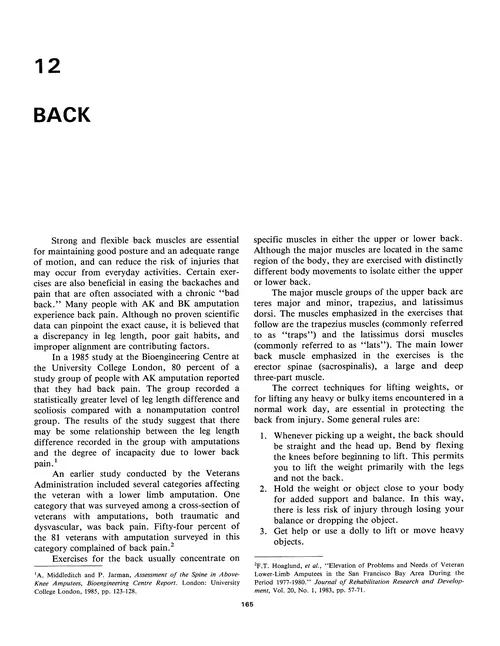
Back exercises - (VA) Rehabilitation Research and Development
UPPER-BACK EXERCISE ROUTINE. Muscle. Exercise. Title. Latissimus Dorsi When performing exercises with free weights, it is recommended that 2-6.
adsPart of the document
12
BACK
Strong and flexible back muscles are essential
for maintaining good posture and an adequate range
of motion, and can reduce the risk of injuries that
may occur from everyday activities. Certain exer-
cises are also beneficial in easing the backaches and
pain that are often associated with a chronic "bad
back." Many people with AK and BK amputation
experience back pain. Although no proven scientific
data can pinpoint the exact cause, it is believed that
a discrepancy in leg length, poor gait habits, and
improper alignment are contributing factors.
In a 1985 study at the Bioengineering Centre at
the University College London, 80 percent of a
study group of people with AK amputation reported
that they had back pain. The group recorded a
statistically greater level of leg length difference and
scoliosis compared with a nonamputation control
group. The results of the study suggest that there
may be some relationship between the leg length
difference recorded in the group with amputations
and the degree of incapacity due to lower back
pain.'
An earlier study conducted by the Veterans
Administration included several categories affecting
the veteran with a lower limb amputation. One
category that was surveyed among a cross-section of
veterans with amputations, both traumatic and
dysvascular, was back pain. Fifty-four percent of
the 81 veterans with amputation surveyed in this
category complained of back pain.2
Exercises for the back usually concentrate on
'A. Middleditch and P. Jarman,Assessment of the Spine in Above-
Knee Amputees, Bioengineering Centre Report.London: University
College London, 1985, pp. 123-128.
specific muscles in either the upper or lower back.
Although the major muscles are located in the same
region of the body, they are exercised with distinctly
different body movements to isolate either the upper
or lower back.
The major muscle groups of the upper back are
teres major and minor, trapezius, and latissimus
dorsi. The muscles emphasized in the exercises that
follow are the trapezius muscles (commonly referred
to as "traps") and the latissimus dorsi muscles
(commonly referred to as "lats"). The main lower
back muscle emphasized in the exercises is the
erector spinae (sacrospinalis), a large and deep
three-part muscle.
The correct techniques for lifting weights, or
for lifting any heavy or bulky items encountered in a
normal work day, are essential in protecting the
back from injury. Some general rules are:
1.Whenever picking up a weight, the back should
be straight and the head up. Bend by flexing
the knees before beginning to lift. This permits
you to lift the weight primarily with the legs
and not the back.
2.Hold the weight or object close to your body
for added support and balance. In this way,
there is less risk of injury through losing your
balance or dropping the object.
3.Get help or use a dolly to lift or move heavy
objects.
2F.T. Hoaglund,et al.,"Elevation of Problems and Needs of Veteran
Lower-Limb Amputees in the San Francisco Bay Area During the
Period 1977-1980."Journal of Rehabilitation Research and Develop-
ment,Vol. 20, No. 1, 1983, pp. 57-71.
165


